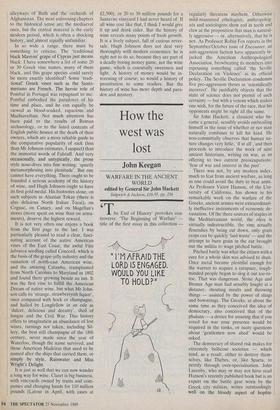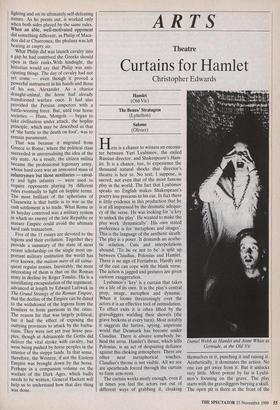How the west was lost
John Keegan
WARFARE IN THE ANCIENT WORLD edited by General Sir John Hackett Sidgwick & Jackson, .f16.95, pp. 256 The End of History' provokes con- troversy. 'The Beginning of Warfare' title of the first essay in this collection — regularly threatens mayhem. Otherwise mild-mannered ethologists, anthropolog- ists and sociologists show red in teeth and claw at the proposition that man is natural- ly aggressive — or, alternatively, that he is not. As Professor Robin Fox reports in the September/October issue of Encounter, an anti-aggression faction have apparently hi- jacked the American Anthropological Association, browbeating its members into espousing something called 'the Seville Declaration on Violence' as its official policy. The Seville Declaration condemns five pro-aggression theses as 'scientifically incorrect'. He justifiably objects that the state of science does not permit of such certainty — but with a venom which makes one wish, for the future of the race, that his opponents might be right all the same.
Sir John Hackett, a classicist who be- came a general, sensibly avoids embroiling himself in the issue of whether or not man naturally combines to kill his kind. He non-committally observes that human na- ture changes very little, 'if at all', and then proceeds to introduce the work of nine ancient historians, writing on war, as an offering to two current preoccupations: `fear of war and interest in the past'.
There was not, by any modern index, much to fear from ancient warfare, as long as one could avoid the duty to bear arms. As Professor Victor Hanson, of the Uni- versity of California, has shown in his remarkable work on the warfare of the Greeks, ancient armies were extraordinari- ly ineffective instruments of economic de- vastation. Of the three sources of staples in the Mediterranean world, the olive is virtually indestructible, the vine actually flourishes by being cut down, only grain crops can be quickly 'laid waste' — and the attempt to burn grain in the ear brought out the militia to wage pitched battle.
Pitched battle was what the citizen with a care for a whole skin was advised to shun. Once metal became plentiful enough for the warrior to acquire a carapace, tough- minded people began to slog it out toe-to- toe. That was dangerous. Stone Age and Bronze Age man had sensibly fought at a distance, shouting insults and throwing things — assisted by the power of slings and bowstrings. The Greeks, at about the same time as they conceived the idea of democracy, also conceived that of the phalanx — a device for assuring that if you voted for war your presence would be required in the ranks, or nasty questions about 'gentlemen now abed' would be asked.
The democracy of shared risk makes for extremely bellicose societies — which tend, as a result, either to destroy them- selves, like Thebes, or, like Sparta, to petrify through over-specialisation. John Lazenby, who may or may not have read Hanson's recently published book but is an expert on the battle gear worn by the Greek city militias, writes outstandingly well on the bloody aspect of hoplite fighting and on its ultimately self-defeating nature. As he points out, it worked only when both sides played by the same rules. When an able, well-motivated opponent did something different, as Philip of Mace- don did at Chaeronea, the phalanx was left beating at empty air.
What Philip did was launch cavalry into a gap he had contrived the Greeks should open in their ranks.With hindsight, the historian would say that Philip was anti- cipating things. The day of cavalry had not yet come — even though it proved a powerful instrument in his hands and those of his son, Alexander. As a chariot draught-animal, the horse had already transformed warfare once. It had also provided the Persian emperors with a battle-winning force. But, until true horse societies — Huns, Mongols — began to take civilisation under attack, the hoplite principle, which may be described as that of 'the battle to the death on foot', was to remain paramount.
That was because it migrated from Greece to Rome, where the political class succeeded in universalising the idea of the city state. As a result, the citizen militia became the professional legionary army, whose hard core was an armoured mass of infantrymen but those auxiliaries — caval- ry and light infantry — were used to require opponents playing by different rules eventually to fight on hoplite terms. The most brilliant of the aphorisms of Clausewitz is that battle is to war as the cash settlement is to trade. What Rome in its heyday contrived was a military system in which no enemy of the late Republic or mature Empire could avoid the ultimate hard cash transaction.
Five of the 11 essays are devoted to the legions and their evolution. Together they provide a summary of the state of most recent scholarship on the single most im- portant military institution the world has ever known, the maison mere of all subse- quent regular armies. Inevitably, the most interesting of them is that on the Roman army in decline by Roger Tomlin. His is a scintillating encapsulation of the argument, advanced at length by Edward Luttwak in The Grand Strategy of the Roman Empire, that the decline of the Empire can be dated to the withdrawal of the legions from the frontiers to form garrisons in the cities. The reason for that was largely political; but it had the effect of exposing the outlying provinces to attack by the barba- rians. They were not yet true horse peo- ples, though at Adrianople the Goths did deliver the vital stroke with cavalry, but were being pushed by horse peoples in the interior of the steppe lands. In that sense, therefore, the Western, if not the Eastern Empire was brought down by the horse. Perhaps in a companion volume on the warfare of the Dark Ages, which badly needs to be written, General Hackett will help us to understand how that dire thing was done.











































































 Previous page
Previous page